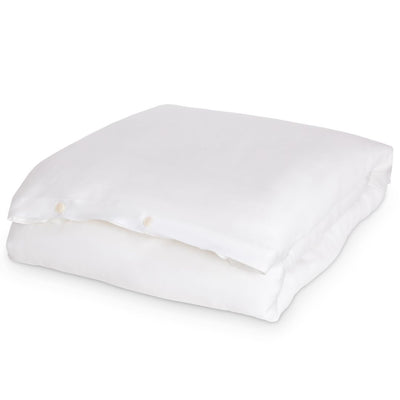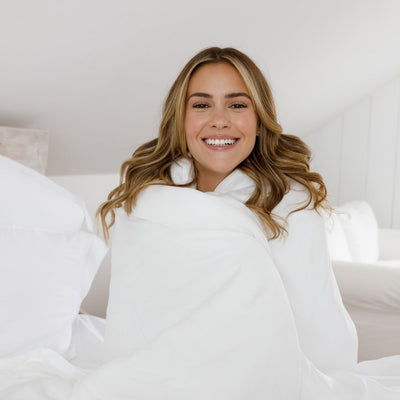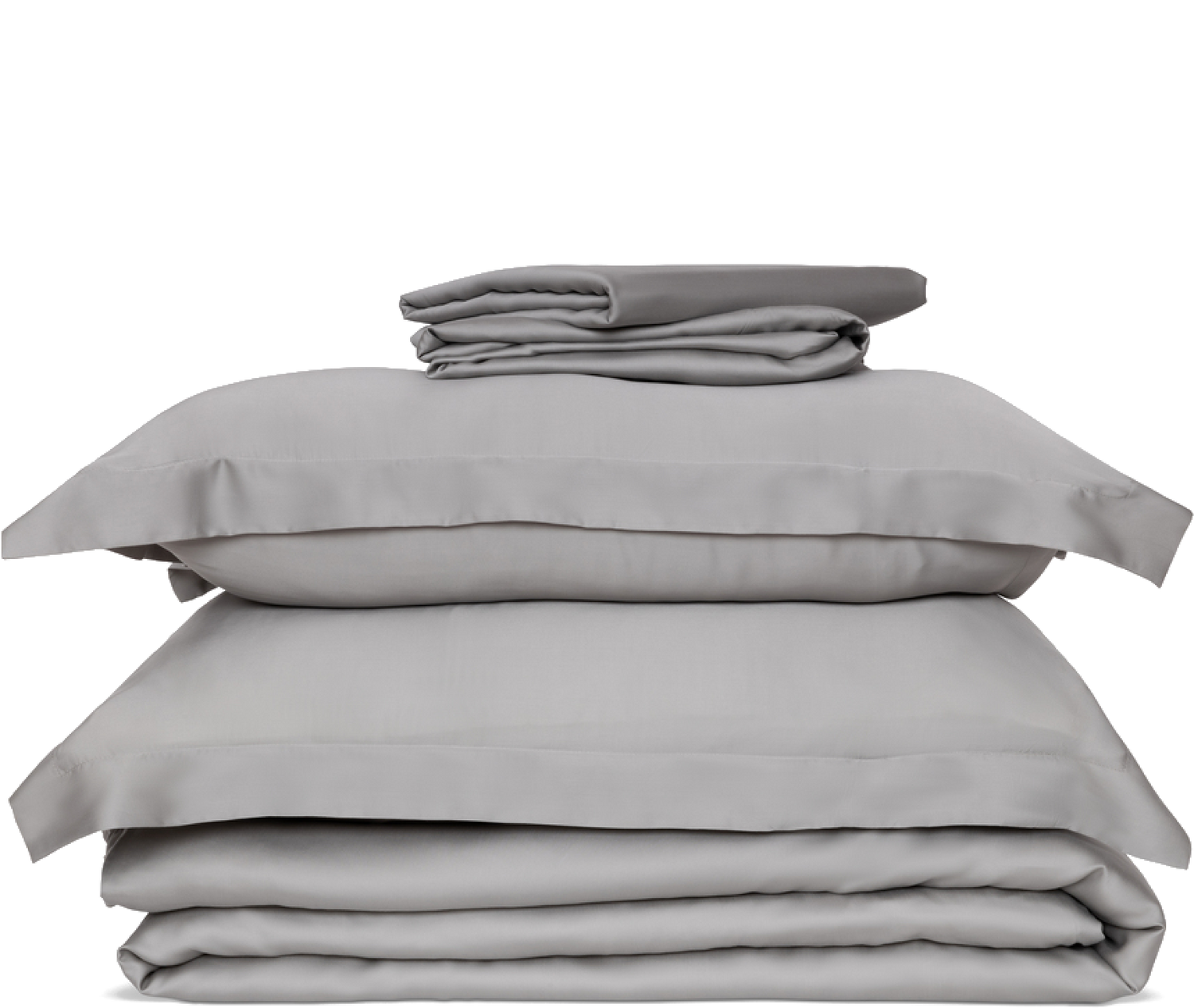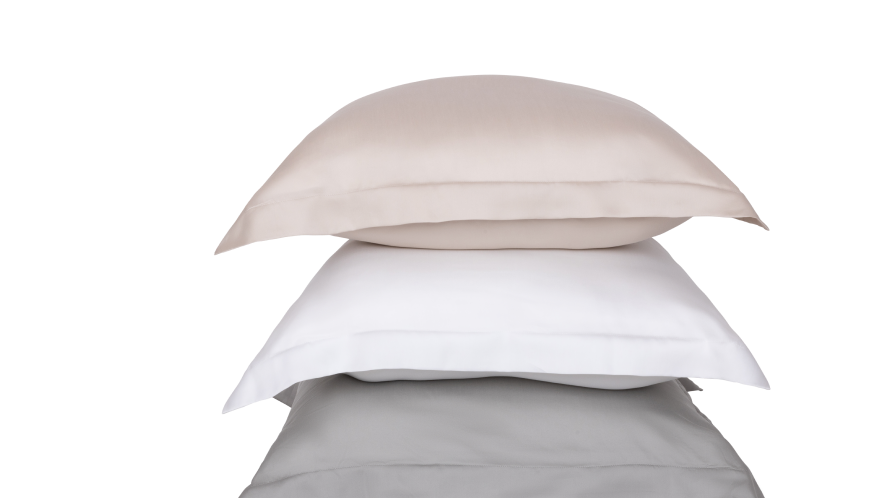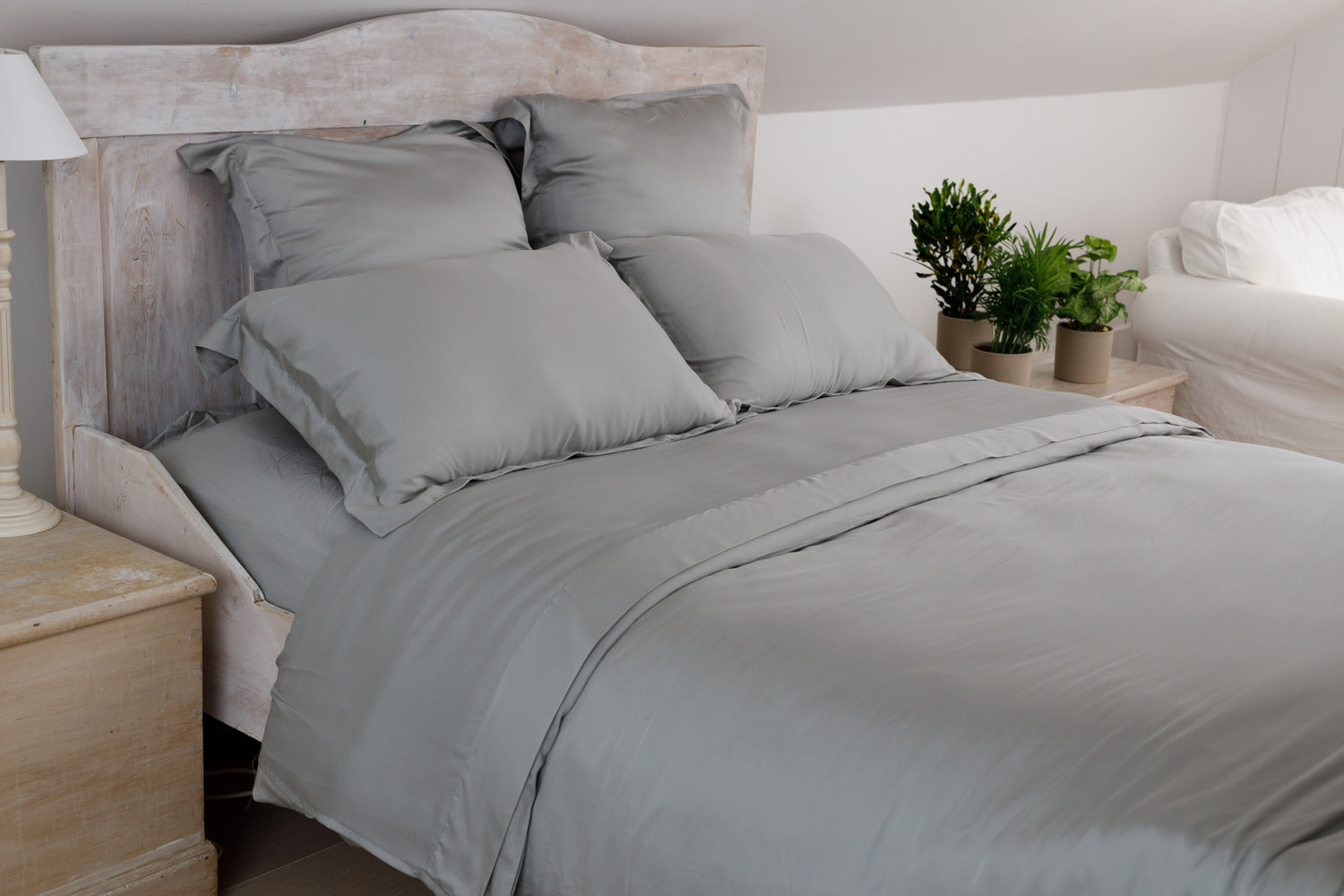Offering comfort, protection and warmth, a great duvet cover is the key to optimal sleeping conditions. In modern day UK, it’s hard to imagine a bedroom that doesn’t feature the dynamic duo of duvet and duvet cover. However, believe it or not, duvet covers and the duvet they enclose have only recently come into fashion.
One thing we're sure you're aware of, though, is that the quality of your sleeping experience is highly dependent upon which duvet cover is used - although choosing the optimal fabric, size and style can be confusing. Fortunately, here at Ethical Bedding, we’ve taken a deep dive look at the range of duvet covers available to make your decision a little easier.

DUVET COVER: KEY QUESTIONS AND INFORMATION
Within this article, we're covered all the key questions, providing in-depth answers to common queries, such as:
- What is a duvet cover?
- History of duvet covers
- Life before duvet covers in the UK
- What are the benefits of duvet covers?
- Duvet usage globally
- Duvet cover materials
- How to put on a duvet cover
- Which duvet cover fabric is right for you?
We think that should just about cover everything...
WHAT IS A DUVET COVER?
To get to grips with duvet covers, we first have to understand the duvet. Essentially, a duvet is a large pocket stuffed with either natural or synthetic materials. The ‘duvet’ name comes from the French word for down, the fine layer of bird feathers that were the traditional duvet filling. Down is still used in many duvets along with other materials including feathers, bamboo, hollow fibres and microfibres, and sustainable bamboo.
Modern duvets come in a variety of sizes, weights and warmth. The warmth of a duvet is measured in something called duvet togs which describes the thermal resistance of the material used. In short, the more togs a duvet has, the warmer it will be.
In the UK, duvets are sold from a light and cool 1.5 togs up to a much warmer and cosier 15 togs - although, if in doubt, it’s typically safe to buy a 7.0 tog duvet, suitable for all seasons.. Duvets are found in a range of sizes from single to super king and are made to be encased in a removable case known as a duvet cover.
A duvet cover is a fabric sheet that encloses a duvet. They are available in every corresponding duvet size, and in a range of fabrics and colours. While a duvet is responsible for keeping you warm from the cold, comfort in bed relies on the combination of the duvet and duvet cover. Importantly, the best duvet covers are made with a fabric that is both soft and able to regulate your body temperature as you sleep, to keep you cool and prevent night sweats.
HISTORY OF DUVET COVERS
The first use of recognisable duvets in history is unknown, but we do know that down was definitely used as bedding during the Viking times in Norway. Since the Vikings, duvets have gained popularity across Scandinavia and Germany. However, despite their Scandinavian popularity, they didn’t make an appearance in the UK until much later.
In fact, English diplomat Paul Rycat was visiting Hamburg in 1689 when he first came across a duvet. He immediately took to the idea and brought the concept back to the UK. Despite Rycat’s marketing, though, the British public were unresponsive to this novel bedding and preferred to stick to traditional options. After the failed attempts to sell duvets in the UK, they disappeared again for many years...
In 1964! Less than 60 years ago, home décor designer , Terence Conran imported duvets and duvet covers from Sweden to the UK with the intention of selling them in London. This time, they were marketed as the ’10 second bed’ and were an immediate hit. As such, duvets and duvet covers gained popularity throughout the 1970s and have now become an essential household item.
LIFE BEFORE DUVET COVERS IN THE UK
Before Duvets and easily washable bed duvet covers became popular in the UK, people kept warm in bed with blankets and quilts. As temperatures fluctuated throughout the year, blankets were added or removed to stay comfortable throughout the night. Blankets and quilts were mostly handmade and passed down through generations or given as gifts which gave them sentimental value.
WHAT ARE THE BENEFITS OF DUVET COVERS
The popularity of duvets and duvet covers comes down to how easy they are to take care of. They're so easy, in fact, that making a bed with a duvet can be done in seconds. This provided a huge relief for bed-makers in the 1960s who previously spent their time organising multiple sheets, blankets and quilts.
With a removable cover, duvets are also much easier to keep clean. Washing and drying a single fabric sheet can be done within a few hours and leaves users with fresh, clean and hygienic bedding.
The huge range of duvet and duvet cover options in size, weight and style means every person can find their ideal bedding. Duvet covers come in every shade of colour and can be matched to complement the style of any room or quickly changed for a new look.

Looking for a soft, durable and hygienic option? Use TENCEL10 to get 10% off our Duvet Upgrade Bundle (various colours)
DUVET USAGE GLOBALLY
While those in hotter climates may still reject a duvet in preference of a simple sheet, duvets and duvet covers have largely become popular across the globe.
Duvet culture has evolved even further in some Scandinavian cultures. Instead of a single duvet shared between a couple in bed, it is not unusual for each person to have a separate duvet. This is perhaps the future for all duvet users as it allows everyone to have their perfect duvet weight and warmth and prevent duvet hogging throughout the night!
DUVET COVER MATERIALS
With so many varieties of duvet to choose from, it can sometimes be difficult to choose the optimum filling for your preferences. To make picking the perfect duvet a little more straightforward, we’ve outlined the key benefits and drawbacks of the most popular types.
Cotton
As the most commonly used bedding fabric worldwide, it’s no surprise that cotton is also frequently used for bedding..
Advantages:
- A cotton duvet covers set is a great, inexpensive option that is readily available.
- Cotton holds colour well, so duvet covers are available in every colour and in a variety of patterns to suit any room or location.
- Cotton is generally a soft fabric and is easy to take care of..
Disadvantages:
- Low-quality cotton tends to get a pilling effect, and duvet covers will need to be replaced every 1-2 years.
- It is also not as breathable as higher quality cottons and fabrics and is susceptible to harbouring allergens.
Egyptian Cotton
A grade above all other types of cotton, Egyptian cotton is known for luxury, and so, has become a popular pick for a number of reasons..
Advantages:
- It is incredibly soft and extremely smooth, thanks to the extra-long staple cotton fibres it is made with.
While Egyptian cotton is an expensive choice for a duvet cover, the breathable fabric, smooth texture and high quality tend to justify its price.
Disadvantages:
- Can be prone to wrinkling and is damaged by hot washes.
- The cotton industry is also questionable, and it can be difficult for consumers to purchase Egyptian cotton ethically.
Linen
Fans of durable fabrics often decide on linen as their duvet covers, with the practical textile found in countless homes.
Advantages:
- It has incredible absorbency and is resistant to stains, so will remain fresh and cool throughout its lifetime.
- Linen is also incredibly strong and is unlikely to tear or wear down.
Disadvantages:
- The downside to bed linen is that it often lacks a luxurious feel and instead feels stiff and crisp, particularly at first.
- Linen is also very expensive and wrinkles easily.
Silk
Silk has long-been the staple choice of bedding for luxury and refinement for thousands of years. But what are the pros and cons?
Advantages:
- It’s a natural fibre made from silk worms that has a smooth satin feel.
- It is notably hypoallergenic, breathable and soft and a healthy, relaxing choice of duvet cover.
Disadvantages:
- Silk is easily damaged and very expensive to buy, clean and repair.
- Production of silk is less than ideal - it uses a lot of energy and water to cultivate the right growing environment, and involves the boiling of millions of silk worms every year.
Polyester
Polyester is a widely used, man-made fibre that is cheap and easy to find. Since polyester on its own is stiff and scratchy, it is typically sold as a cotton-polyester blend.
Advantages:
- It can be repeatedly washed and is resistant to wear and tear.
Disadvantages:
- The quality of the fab will be significantly lower than others available.
- Polyester is not very breathable, and users will find they are more likely to wake up feeling sweaty and damp.
Tencel™
Tencel™ is the newest luxury fabric to make an entrance. It combines ethical practices, sustainable production and a high-quality feel.
Advantages:
- Tencel™ is made from sustainably sourced wood pulp harvested from responsibly governed farms.
- It is durable, soft, naturally hypoallergenic, and extremely hygienic, due its single cellular structure.
- The smooth texture of Tencel™ duvet covers is unmatched and its breathable qualities means users will be kept cool and comfortable throughout the night.

In need of a new duvet cover? Shop Ethical Bedding's unique, super soft and eco-friendly duvet cover (various colours)
HOW TO PUT ON A DUVET COVER?
So, now you know all there is to know about duvets, it’s time to learn how to change a duvet cover. It might be a chore you dread, but you’ll soon be changing bedding like a pro.
The Traditional method
The traditional way of putting on a duvet cover is quite simple, so long as you closely follow the step-by-step process:
- Lay your duvet neatly over your bed, as though you would if you were to make your bed.
- Turn your duvet cover inside out, and lay over your duvet with the opening at the bottom of your bed. Make sure that all corners are carefully aligned with your duvet’s corners.
- Place your hands inside your inside out duvet cover and grab the top corners of your duvet from within.
- Pinch each corner, holding onto both the duvet and cover, and flip the cover so it’s no longer inside out.
- Continuing to hold the corners, carefully lift and wriggle the cover down over the rest of the duvet.
- Once done, hold the corners of your duvet and cover at the open end, and give everything a good shake to get rid of any clumping.
And there you go! Hopefully, you’ve been able to master the traditional method of fitting a duvet cover. But if not, why not try the famous California roll method instead…
The California Roll method
The easy way to put a duvet cover on, otherwise commonly referred to as the ‘California roll’ or ‘burrito method’, comprises of a handful of straightforward steps that anyone can follow:
- Turn your duvet cover inside out, and lay it flat with the opening at the bottom of your bed. Ensure the cover is opened out across your full bed.
- Lay your duvet on top of your inside out cover, making sure all edges line up nicely and neatly. This is very important, as the California roll is reliant on everything being lined up exactly.
- With everything aligned, hold onto the edge over both duvet and cover at the head of your bed (opposite the opening of your cover), and roll as tightly as you can. As you work along, you may need to adjust your roll to keep everything together.
- Once you’ve rolled all the way to the end of your bed, your bedding should now somewhat abstractly resemble a burrito. If so, grab one end and open the duvet cover.
- Stuff your duvet inside the open cover, and fasten any buttons or zip.
- Finally, unroll the duvet towards the head of your bed, shaking as you go along so the filling doesn’t clump up.
- Voila! There you go – the easy way to put a duvet cover on.
WHICH DUVET COVER FABRIC IS RIGHT FOR YOU?

The ideal size, weight and warmth of a duvet is entirely dependent on the time of the year and your own personal preference.
While silk, Egyptian cotton and Tencel™ could each claim to be the softest or the most breathable, only Tencel™ also offers the full package.
With unbeatable quality and a completely ethical production process, Tencel™ is the most luxurious fabric that deservedly takes the crown as the best fabric for duvet covers.


